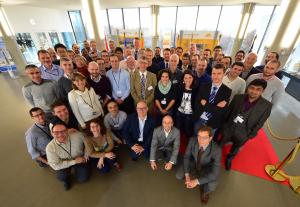Making remote handling less remote
Over a wet and windy three-day period on the ITER site in November, around 90 representatives of the ITER Organization, the Domestic Agencies of Europe and Japan, and industry came together for the second ITER Remote Handling Progress Review and Standardization Workshop.
Building on the success of its predecessor, held in Barcelona in 2015, this workshop provided a rare opportunity for industrialists, researchers and system integrators currently working on ITER remote handling systems to identify opportunities for collaboration and cross-fertilization between as many as six different ITER procurement packages. It also gave this rapidly growing ITER community the opportunity to compare notes and combine efforts on common technological challenges such as the cutting, welding and non-destructive testing of a multitude of ITER in-vessel cooling pipes.
A major proportion of the event was dedicated to allowing a number of laboratories and small and medium-sized enterprises to showcase their latest technological developments in fields of common interest to the entire remote handling community, such as radiation-hard electronics, cameras, control systems, condition monitoring and water hydraulics. It was clear that all of these latest developments are showing great potential for some level of in-field deployment within the ITER timeframe.



